The Opteron 6166 HE is a dodeca (12) core CPU running at 1.8GHz. Utilizing the Magny Cours G34 platform, the Opteron 6166 HE is dual and quad socket ready. In each package there are essentially two Opteron 4100 series CPUs stitched together that combine for 6MB of L2 cache and 12MB of L3 cache per package alongside access to four DIMM channels. As one will see, the Opteron 6166 generally compares favorably to the Intel Xeon L5640 which is Intel’s low-power dual socket Xeon mainstay.
Test Configuration
Recently I acquired two AMD Opteron 6164 HE’s and eight Opteron 6166 HE’s and the 6166 HE chips were used for this review.
- CPUs: 2x AMD Opteron 6166 HE’s
- Motherboard: Tyan S8236WGM3NR
- Memory 8x 2GB ECC DDR3 UDIMMs
- OS Drive: OCZ Agility 2 120GB
- Enclosure: Norco RPC-4224
- Power Supply: Seasonic X650 (650w Gold level power supply)
One may think that a 650w PSU would not be enough to drive a 24 core, 45nm server board with eight DIMMs and an onboard LSI controller would consume copious amounts of power that a single 650w PSU could not handle. This would be an incorrect assumption.
Performance Tests
I will start off this section by saying that the standard test suite was built to test UP platforms. I have seen repeatedly that at twelve core counts and higher that some of the tests simply do note scale with cores. As a result, I am adding a few new tests to the suite for the 12-48 physical core reviews. These will be added as I can get them to be repeatable and consistent, but I am getting close, really close on a few.
Windows Experience Index
Personally, I think that Microsoft’s built-in relative performance indicator, the Windows Experience Index (WEI) does not do enough to stress and stratify CPUs, especially at the upper-end. With that being said, a lot of readers ask for WEI scores so I have learned to oblige.

With a total of over 40GHz worth of native cores on tap, it is clear that WEI is not well threaded.
Cinebench R11.5
I have been using Cinebench benchmarks for years but have held off using them on ServeTheHome.com because the primary focus of the site until the past few months has been predominantly storage servers. With the expansion of the site’s scope, Cinebench has been added to the test suite because it does represent a valuable benchmark of multi-threaded performance. I have had quite a few readers contact me about this type of performance for things like servers that are Adobe CS5 compute nodes and similar applications. Cinebench R11.5 is something that anyone can run on their Windows machines to get a relative idea of performance.
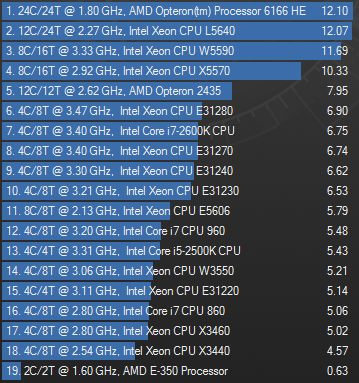
As one can see, AMD is very competitive here. Each L5640 is approximately $1000 and is Intel’s low-power server part. On the other hand, AMD’s Opteron 6166 HE runs about $750 each meaning that one gains a slight amount of performance for $500 less using AMD’s architecture. This is one of those use cases where AMD really shines against Intel’s direct competition. For those looking at rendering applications where workloads are highly parallelized, the Opteron 6100 makes a strong case.
7-Zip Compression Benchmark
7-Zip is an immensely popular compression application with an easy to use benchmark.
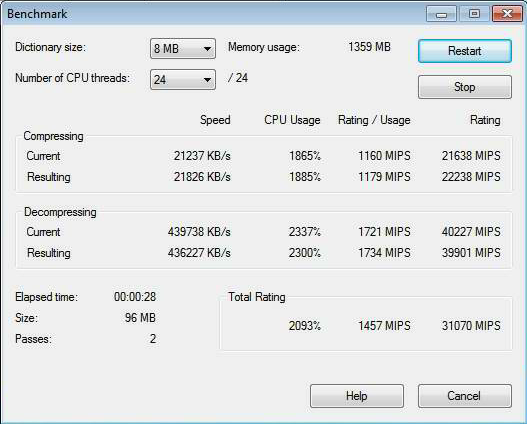
I was surprised to see the dual dodeca cores fall into the range they did. Here is a comparison of some other server CPU configurations:
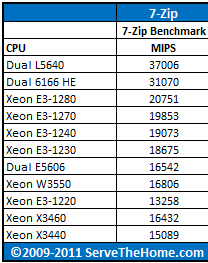
One can see the dual dodeca cores deliver good, but not top performance in 7-Zip.
TrueCrypt Encryption Benchmarks
With Intel’s focus on its AES-NI features TrueCrypt can look a bit skewed. Unlike some dubious drivers over the years that were optimized for benchmarks over real world application, Intel’s AES-NI feature does encompass the addition of specialized hardware. This specialized hardware has many practical uses and is becoming more supported. For example, users of Solaris 11 can utilize the AES-NI features to see much higher throughput on encrypted volumes. AMD will be following suit starting with their next generation parts, but for now, the Opteron 6100 series does not have AES acceleration. Without further waiting, here is the AMD Dual Opteron 6166 HE TrueCrypt benchmark run:
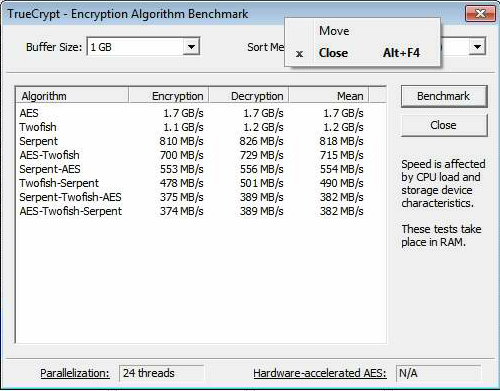
First off, apologies for letting the menu into the screen grab. This is a bit of a mixed bag for AMD. On on hand, Intel’s high-end Westemere-EP CPUs simply have more AES crunching power that AMD cannot math with this generation of CPUs. On the other hand, if one looks beyond the AES number, AMD fares well. For comparison, here is the dual Intel Xeon L5640 run:
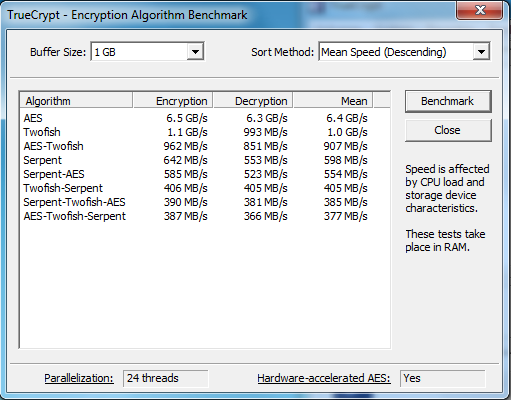
Comparing Intel Xeon L5640 to the AMD Opteron 6166 HE parings one can see that AES-NI really helps the Intel CPUs, but beyond that, AMD is actually competitive, beating Intel in many cases. Overall, the fact that Intel and AMD are both going to have virtually “free” AES modes in the next few months will mean that AES encryption will become even more prevalent and therefore relevant in the future. On the other hand, those looking at other forms of encryption will actually enjoy equal to better performance on the AMD architecture. One can also note that 1.7GB/s is still a strong result from the dual Opteron 6166 HE configuration. Putting this into perspective, this is equivalent throughput to approximately four Intel Xeon X3460’s running in tandem.
Folding@Home
I am working to make Folding@Home a standardized benchmark, as it is a mature distributed computing client. I will post more information here once I get the methodology perfected and can run this on a few configurations. I will say that I was able to garner sub-16 minute frame times with this configuration. A frame is equivalent to 1% of the work units completion. For reference, the Opterons were slightly slower than the Dual Xeon X5670’s I have on hand. The difference being, of course, that the Opteron 6166 HE’s are lower power chips that cost about half of the X5670’s per-chip cost.
Handbrake 0.9.5 x264 Encoding Benchmarks
I am not devoting much time to the standard Handbrake results because the chips had <10% utilization and 155fps using the standard definition tests and 18.8fps using the hi-definition tests. Clearly, the benchmark failed to stress two 12 core CPUs.
Power Consumption
One area where the AMD Opteron 6166 HE’s really did well in was power consumption. Running at full load with eight DIMMs one saw 227w, which is very low.
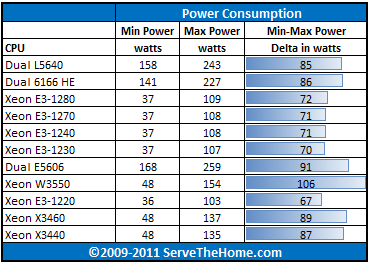
As some perspective, AMD has an architecture delivering under 10w per core while working at 100% capacity. That is awesome! Both AMD and Intel talk about cores per watt as a key performance indicator, but in doing so usually use TDP or ACP figures. This was a great result.
Conclusion
Overall the Opteron 6166 HE’s performed well in a dual socket configuration. There were times when AMD’s $750 per CPU chips were able to outpace Intel’s $1,000 Xeon L5640. One really great thing about the Opteron 6166 HE and AMD’s other Opteron 6100 offerings is that the chips are quad socket capable like the Xeon X series. AMD prices the 6100 series so as to provide customers with two CPUs for the price of one Intel Xeon X series part. With the low platform power consumption, the Opteron 6166 HE’s offer some really great application performance for the price. For those in virtualized environments, the Opteron 6166 HE’s simply allow for very high native core counts. In scenarios like virtual private server hosting, one can provision the multitude of CPU cores among customers.
Feel free to discuss this article in the ServeTheHome.com Forums!




Great love to hear the quad results and F@H results.
Yea go quads! My small business rendering farm needs an upgrade.
Any idea on if/when you will review the new Llano/Lynx/A8-3850? I am keen to see what alternatives there are to Intel that support ECC and also have low power requirements. Also, do you know if there will be a higher reliability Opteron version of those chips, and would you get them over the desktop versions? Thanks.
Those are server chips.
most if not all Opterons support ECC.
BSD guy that is something I am looking at strongly. Just have been very busy.